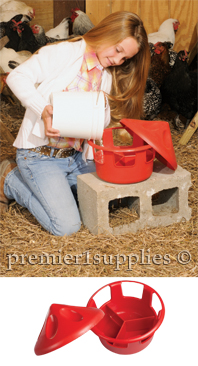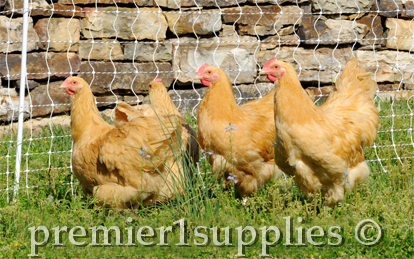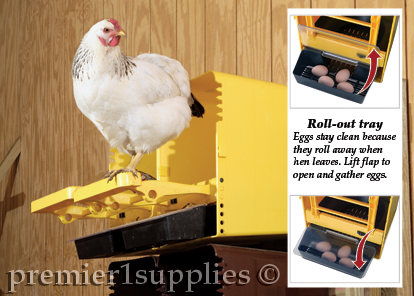PREMIER PICK
 Grit & Shell Station
Grit & Shell Station
Grit aids digestion. Oyster shell enables stronger egg shells. This feed station is perfect for feeding both. Use for all poultry, inside the coop and out. Removable lid makes filling easy and helps protect feed from the outdoor elements.
POULTRY NUTRITION
Supplements
Eggshells are made of calcium. To lay eggs with hard shells, a hen needs adequate calcium in her diet. Lay ration contains enough calcium for pullets, and hens that forage freely find plenty of calcium in the form of hard-shelled insects. Older hens that do not forage need supplemental calcium to keep them from laying thin-shelled eggs that break easily.
Farm stores carry supplemental calcium in the form of ground oyster shell or limestone (but do not feed dolomitic limestone, which can harm egg production). Place the calcium supplement in a hopper where your hens can eat as much as they want. Fill a second hopper with granite grit, which chickens need to eat because they have no teeth. Everything the chick eats passes through the gizzard; the grit lodges in the gizzard and grinds feed up finely enough to be digestible. Foraging chickens may find sufficient pebbles and sand to use as grit, but you can’t count on their finding enough.
Granite grit is sometimes called insoluble grit, meaning it wears down over time rather than dissolving. Calcium supplements, by contrast, are sometimes called soluble grit, because the particles are hard and may temporarily serve the same purpose as grit until they dissolve. This distinction may be important in making sure you get the right thing when you ask for grit at the farm store.
Grit
The digestive system of a bird starts with its crop, where swallowed food is stored. From there, it goes into a tough organ called the gizzard, where food particles are rubbed against pebbles and sand the bird has eaten. This grit acts as the bird’s teeth to grind up food matter so it can be digested. Eventually the grit, too, gets ground up in the process and must be continually renewed.
Ducks and geese that spend time foraging pick up natural grit in the course of their daily activities. To make sure they get enough for proper digestion, insoluble grit should be available at all times. Granite grit may be purchased at a farm store. If you prefer, you may substitute clean coarse sand or fine gravel from a clean riverbed. Ocean sand may also be used, but it must be thoroughly leached of salt to avoid salt poisoning.
Information taken from Barnyard In Your Backyard book. Published by Storey Publishing and edited by Gail Damerow.
RECIPES
Egg Casserole
Ingredients:
| • |
2 tsp olive oil
|
| • |
12 oz (baby bella) mushrooms, sliced
|
| • |
4 cups (packed) fresh spinach, roughly chopped
|
| • |
1/2 tsp salt
|
| • |
1/2 tsp freshly ground black pepper
|
| • |
1/2 cup salsa
|
| • |
5 eggs
|
| • |
5 egg whites
|
| • |
1/3 cup water
|
| • |
2 green onions, thinly sliced
|
| 1. |
Preheat the oven to 375 degrees F. Coat a 7- by 11-inch ceramic or glass baking dish with cooking spray.
|
| 2. |
Heat 1 tsp olive oil in a large skillet set over medium heat. Add the mushrooms and cook, stirring occasionally, until the mushrooms are tender.
|
| 3. |
Add the remaining 1 tsp olive oil and the spinach. Cook until the spinach is cooked down and bright green, 1 to 2 minutes. Season with the salt and pepper. Pour off any extra liquid from the mushrooms.
|
| 4. |
Spread the mushroom and spinach mixture evenly on the bottom of the prepared baking dish. Spoon the salsa over top.
|
| 5. |
In a large bowl, whisk together the eggs, egg whites and water. Pour the eggs over the mushroom mixture. Sprinkle the green onions over top.
|
| 6. |
Bake until the eggs are set and starting to turn light golden brown, about 25 minutes. Test the eggs by poking a small sharp knife into the middle of the eggs. It should come out clean.
|
| 7. |
Let the casserole sit for about 5 minutes, then cut and serve.
|
Chicken Cheese Dip
Ingredients:
| • |
5 cups shredded chicken
|
| • |
2 cans cream of chicken soup
|
| • |
8 oz hot pepper cheese
|
| • |
1-1/2 cup Velveeta cheese
|
| • |
16 oz cream cheese
|
| • |
16 oz sour cream
|
| • |
8 oz jalapeno peppers
|
| • |
Medium onion, chopped
|
| • |
1 green pepper, chopped
|
| • |
Dash of garlic
|
Chunk up the cheeses for easier melting. Mix all ingredients in a slow cooker and heat, stirring often until cheese is melted. Serve with tortilla chips or crackers.
|
 |
 |

A group of Buff Orpington hens enjoying some time in the pasture. PoultryNet™ while not as substantial as the stonewall in the background, is better able to deter predators when electrified.
No longer a "Spring Chicken"
This spring's chicks are now the pullets (and cockerels) of summer. Their feathers are in and we can now tell which breeds we received. Black Minorcas seem to be the most numerous breed we have. There are a few Light Brown Rose Combed Brown Leghorns, Partridge Rocks, well-muscled Dominiques, Partridge Cochins, Red Leghorns and Egyptian Fayoumis.
We're a month or so away from the hens laying their first eggs, but folks with more mature birds are likely in the "What am I going to do with all these eggs?" season. Find recipes that use eggs. Below left is a simple egg casserole recipe that can be spiced up with garden-fresh veggies and seasonings to keep things interesting.
If you're having trouble with something else eating your eggs, check out the solutions from Lisa Steele below.
|
VIP ARTICLE
Egg Eating - 7 Causes and Ways to Break this messy Habit
By Lisa Steele from Fresh Eggs Daily
Egg eating by your chickens is a bad habit that gets harder to break the longer you let it go on. It is obviously undesirable to have your flock laying eggs and proceeding to eat them, regardless of whether you sell the eggs or use them in your own family's kitchen. Many say that culling the offenders is the only way to stop it, but I offer that there are a few less drastic solutions.
It generally starts by accident. An egg gets stepped on or otherwise breaks, one curious hen pecks at it and thinks - hmm this tastes good. She will then start breaking eggs as they are laid, and soon other hens will follow her lead and you'll have a whole flock laying eggs and proceeding to eat them.
There are several things that can
cause egg eating to start:
1) Weak-Shelled Eggs
Even a good layer feed doesn't provide enough calcium for really strong shells. If your shells are weak, a hen can step on and inadvertently break it. Providing free-choice oyster shell or crushed eggshell can help with that. As long as you crush the eggshells into 1/4" or smaller pieces, the chickens won't associate the shells with eggs, so don't worry about feeding crushed eggshell leading to egg eating. I have been doing it for years and not had one incidence of egg eating. Ever.
2) Not Enough Bedding in the Nesting Boxes
There should be at least 2" of soft bedding (such as straw, pine shavings, shredded paper) in the nesting boxes to prevent eggs from breaking on the hard floor. I have tried both straw and shavings, but prefer straw for the nesting boxes. I have found it holds its shape better, whereas with shavings, the chickens will make a "bowl" in it right down to the nesting box floor and the egg will be sitting on the bare floor.
3) Not Enough Nesting Boxes
You should provide one nesting box for every four to five hens. That's not to say that they won't all want to use the same one, but it can cut down on scuffles and broken eggs to provide enough boxes (or baskets).
4) Broody Hens
Broody hens can contribute to broken eggs when they fight to hold their ground and not give up a nest. Yet another good reason to break broodies if you aren't hatching eggs.
5) Leaving Eggs in the Nesting Boxes After They are Laid
Eggs should be collected as quickly as possible to avoid having them sitting in the nesting boxes, creating a temptation.
Replace the eggs with golf balls, plastic Easter eggs, ping pong balls, wood or ceramic eggs, so your chickens will start to find that when they peck at "eggs" they don't break and tasty yummy inside after all.
Another trick is to blow out some eggs and fill them with mustard and Tabasco hot sauce. The hens will learn pretty fast that eggs don't taste good. Some say that hens can't taste the hot sauce, but it can't hurt to add a bit.
6) Not Enough Protein
Oddly enough, feeding your chickens eggs can actually get them to stop eating their eggs. A protein deficiency can make them crave the egg, so add some scrambled eggs to their diet and see if that puts a stop to it.
7) High-Visibility Nesting Boxes
Believe it or not, hanging curtains across the front of your nesting boxes can deter egg eating. Apparently "out of sight, out of mind" applies here. The curtains not only shield the eggs from open view, they make the boxes darker. If passing hens can't see the eggs as well, they aren't as tempted to investigate.
Other causes may be boredom, which can be "cured" by providing outdoor roosts or logs for your hens to stand on, piles of dirt, leaves or weeds to rummage through, a hanging treat feeder or even a mirror in the coop or run.
With a little persistence, it is possible to break a hen of egg eating. Culling should only be considered as a last resort.
|
SAVE THE EGGS!

Having issues with your hens eating eggs?
Eggs can be as irresistible to hens as they are to us. Once a hen has learned to crack an egg, it is often difficult to catch and stop her of this practice.
There are a few ways to discourage egg eating—
| • |
Make sure the feed is meeting their nutritional requirements.
|
| • |
Blow out an egg and fill it with mustard. When the hens break it open, they will be sorely disappointed.
|
| • |
Place a wooden or ceramic egg in the nest box. They will be unable to crack it and will eventually learn to leave the eggs alone.
|
| • |
Use nest boxes with roll out trays. After the hen lays the egg, it will roll down the tray and into a collection box. There it safely lays until someone arrives to collect the eggs.
|
| • |
If possible, collect eggs frequently while the hens are laying—so there's less time for breakage and egg eating.
|
|

See the video above for ChickBox assembly instructions.
|
We found the ChickBox™ with a roll out tray to be easy to assemble and install in our coop. Just the right amount of bedding is needed with the roll out tray. Too much bedding will prevent the eggs from rolling into the tray, but if there is too little bedding the hens may not choose to lay in the box. To prevent roosting on top of the ChickBox, we installed a slanted board.
For us, the ChickBox increases egg hygiene and speeds up egg collection. This system keeps eggs clean because they slowly roll out into the front tray after the hen steps out of the nest. The cover flap on the roll-out tray prevents any egg pecking or soiling from occurring.
POULTRY FAQs
Often asked Questions about Poultry and Eggs
By Joe Berry, Extension Poultry Specialist, Oklahoma Cooperative Extension Service
Poultry
1. How long do chickens live?
Answer: Chickens in small flocks live several years if conditions are correct. A life span of six to eight years may not be unreasonable. Most commercial layers are kept for two to three years.
2. How old are chickens when they begin to lay eggs?
Answer: Under optimum conditions; good nutrition, ideal day length, adequate housing, and good management practices, most layers should begin egg production at about 20-22 weeks of age.
3. What should chickens be fed?
Answer: Commercial rations will usually produce the best results from all types of poultry. A ration designed specifically for a particular type of bird should always be used (ie. layer ration for layers, broiler ration for broilers, etc.). The commercial ration should not be supplemented with scratch, corn, or table scraps because the birds will not be eating a balanced diet.
4. How can the sex of baby chicks be determined?
Answer: Vent sexing by an experienced chick sexer can be done at one day of age. This technique is difficult and requires a great deal of experience. If a fast feathering gene has been introduced into the breeding flock, chicks can be sexed by observing the differences in the appearance of the primary wing feathers. The feathers on the wings of the female will be a little longer and in a different pattern than those on the males. Most chickens cannot be sexed in this manner.
Read More »
|
|